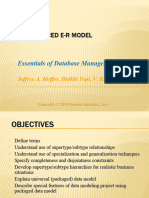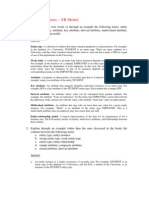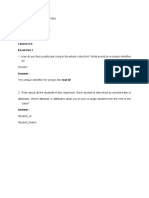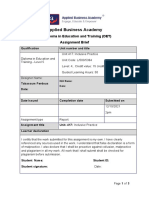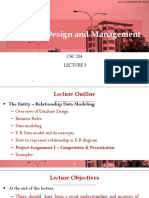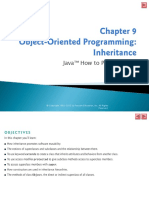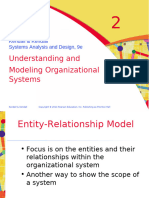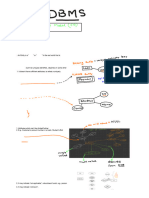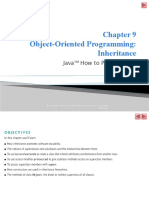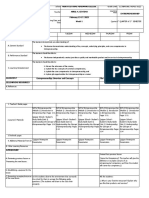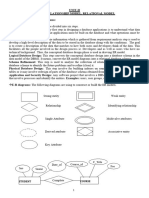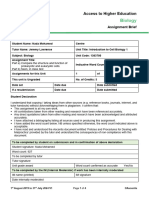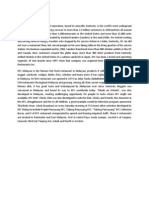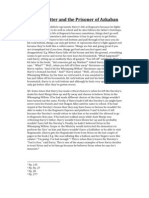0 ratings0% found this document useful (0 votes)
56 viewsRelationship Diagram (ER Diagram)
Relationship Diagram (ER Diagram)
Uploaded by
JESHUA MARK BAYCopyright:
© All Rights Reserved
Available Formats
Download as PPT, PDF, TXT or read online from Scribd
Relationship Diagram (ER Diagram)
Relationship Diagram (ER Diagram)
Uploaded by
JESHUA MARK BAY0 ratings0% found this document useful (0 votes)
56 views33 pagesOriginal Title
DATABASE.ppt
Copyright
© © All Rights Reserved
Available Formats
PPT, PDF, TXT or read online from Scribd
Share this document
Did you find this document useful?
Is this content inappropriate?
Copyright:
© All Rights Reserved
Available Formats
Download as PPT, PDF, TXT or read online from Scribd
Download as ppt, pdf, or txt
0 ratings0% found this document useful (0 votes)
56 views33 pagesRelationship Diagram (ER Diagram)
Relationship Diagram (ER Diagram)
Uploaded by
JESHUA MARK BAYCopyright:
© All Rights Reserved
Available Formats
Download as PPT, PDF, TXT or read online from Scribd
Download as ppt, pdf, or txt
You are on page 1of 33
A tool for communications between database
designers and end users during the analysis phase
of database development.
describes the structure of a database with the help
of a diagram, which is known as Entity
Relationship Diagram (ER Diagram).
Chapter 2 Copyright © 2014 Pearson Education, Inc.
Chapter 2 Copyright © 2014 Pearson Education, Inc.
E-R MODEL CONSTRUCTS
Entities:
Entity instance–person, place, object, event, concept in the
user environment about which the organization wishes
to maintain data
Examples of entities:
•Person: Employee, Student, Patient
•Place: Store, Building
•Object: Machine, product, and Car
•Event: Sale, Registration, Renewal
•Concept: Account, Course
Chapter 2 Copyright © 2014 Pearson Education, Inc.
one that exists independently of other entity type
ex: STUDENT, EMPLOYEE, COURSE
Chapter 2 Copyright © 2014 Pearson Education, Inc.
An entity that cannot be uniquely identified by its
own attributes and relies on the relationship with
other entity.
Chapter 2 Copyright © 2014 Pearson Education, Inc.
An attribute describes the property of an entity.
There are four types of attributes:
1. Key attribute
2. Composite attribute
3. Multivalued attribute
4. Derived attribute
Chapter 2 Copyright © 2014 Pearson Education, Inc.
A key attribute can uniquely identify an entity from an
entity set.
Chapter 2 Copyright © 2014 Pearson Education, Inc.
An attribute that is a combination of other attributes.
Chapter 2 Copyright © 2014 Pearson Education, Inc.
An attribute that can hold multiple values.
It is represented with double ovals in an ER Diagram.
Chapter 2 Copyright © 2014 Pearson Education, Inc.
An attribute based on another attribute.
It is represented by dashed oval in an ER Diagram.
For example, for a circle, the area can be derived from
the radius.
Chapter 2 Copyright © 2014 Pearson Education, Inc.
Chapter 2 Copyright © 2014 Pearson Education, Inc.
REQUIRED VS. OPTIONAL ATTRIBUTES
Required – must have a value for every Optional – may not have a value for
entity (or relationship) instance with every entity (or relationship) instance
which it is associated with which it is associated
Chapter 2 Copyright © 2014 Pearson Education, Inc.
singular noun
specific to the organization
concise as possible
the name used for the same type entity type
should be the same on all ER diagram on which
the entity type appears.
Chapter 2 Copyright © 2014 Pearson Education, Inc.
Attributes Attributes
Entities Entities
Chapter 2 Copyright © 2014 Pearson Education, Inc.
An association among the instances of one or more
entity types that is of interest to the organization
A relationship is represented by diamond shape in ER
diagram
Chapter 2 Copyright © 2014 Pearson Education, Inc.
1. One to One
2. One to Many
3. Many to One
4. Many to Many
Chapter 2 Copyright © 2014 Pearson Education, Inc.
Chapter 2 Copyright © 2014 Pearson Education, Inc.
When a single instance of an entity is associated
with a single instance of another entity
Chapter 2 Copyright © 2014 Pearson Education, Inc.
When a single instance of an entity is associated
with more than one instances of another entity
Chapter 2 Copyright © 2014 Pearson Education, Inc.
When more than one instances of an entity is
associated with a single instance of another entity
Chapter 2 Copyright © 2014 Pearson Education, Inc.
When more than one instances of an entity is associated
with more than one instances of another entity
Chapter 2 Copyright © 2014 Pearson Education, Inc.
Figure 2-17 Examples of cardinality constraints
a) Mandatory cardinalities
A patient history is A patient must have recorded
recorded for one and at least one history, and can
only one patient have many
Chapter 2 Copyright © 2014 Pearson Education, Inc.
29
Figure 2-17 Examples of cardinality constraints (cont.)
b) One optional, one mandatory
A project must be An employee can be assigned
assigned to at least one to any number of projects, or
employee, and may be may not be assigned to any
assigned to many at all
Chapter 2 Copyright © 2014 Pearson Education, Inc.
30
Figure 2-17 Examples of cardinality constraints (cont.)
c) Optional cardinalities
A person is
married to at most
one other person,
or may not be
married at all
Chapter 2 Copyright © 2014 Pearson Education, Inc.
31
Figure 2-20 Examples of multiple relationships
a) Employees and departments
Entities can be related to one another in more than one way
Chapter 2 Copyright © 2014 Pearson Education, Inc.
32
Chapter 2 Copyright © 2014 Pearson Education, Inc.
In a University, a student enrols in Courses. A
student must be assigned to atleast one or more
courses. Each course is taught by a single
Professor.To maintain quality instruction, a
professor can deliver only one course.
Chapter 2 Copyright © 2014 Pearson Education, Inc.
We have three entities
Student
Course
Professor
In a University, a student enrols in Courses. A student must be assigned to
atleast one or more courses. Each course is taught by a single Professor.To
maintain quality instruction, a professor can deliver only one course.
Chapter 2 Copyright © 2014 Pearson Education, Inc.
We have the following two relationships
The student is assigned a course
Professor delivers a course
In a University, a student enrols in Courses. A student must be assigned to
atleast one or more courses. Each course is taught by a single Professor.To
maintain quality instruction, a professor can deliver only one course.
Chapter 2 Copyright © 2014 Pearson Education, Inc.
For them problem statement we know that,
A student can be assigned multiple courses
A Professor can deliver only one course
Chapter 2 Copyright © 2014 Pearson Education, Inc.
Chapter 2 Copyright © 2014 Pearson Education, Inc.
Chapter 2 Copyright © 2014 Pearson Education, Inc.
You might also like
- VOICE CULTURE-S A K Durga, PG No 144 VOICE CULTURE-S A K Durga, PG No 144Document15 pagesVOICE CULTURE-S A K Durga, PG No 144 VOICE CULTURE-S A K Durga, PG No 144sjeyarajah21No ratings yet
- Chapter 2Document51 pagesChapter 2vennelaNo ratings yet
- Hoffer Edm PP ch03Document28 pagesHoffer Edm PP ch03Urvish BarapatreNo ratings yet
- Hoffer Edm PP Ch03Document28 pagesHoffer Edm PP Ch03somasekharchNo ratings yet
- DB Chapter 03 The Enhanced ER ModelDocument28 pagesDB Chapter 03 The Enhanced ER ModelMuhammad Asif JavaidNo ratings yet
- ch04 - ER ModelingDocument51 pagesch04 - ER ModelingNur Suraya AazizNo ratings yet
- CH 12Document45 pagesCH 12Hanako OnoNo ratings yet
- Hoffer Mdm10e PP Ch02-1Document38 pagesHoffer Mdm10e PP Ch02-1Muhammed Ali MireNo ratings yet
- Solution Manual For Essentials of Database Management 1st Edition by Hoffer Topi and Ramesh ISBN 0133405680 9780133405682Document36 pagesSolution Manual For Essentials of Database Management 1st Edition by Hoffer Topi and Ramesh ISBN 0133405680 9780133405682kennethflowerswcymoixfbe100% (36)
- Chapter 2Document33 pagesChapter 2Khalid IbrahimNo ratings yet
- (Database Management Systems) : Biag, Marvin, B. BSIT - 202 September 6 2019Document7 pages(Database Management Systems) : Biag, Marvin, B. BSIT - 202 September 6 2019Marcos JeremyNo ratings yet
- Chap 2 - Modeling Data in The OrganizationDocument49 pagesChap 2 - Modeling Data in The OrganizationAkari YukimuraNo ratings yet
- Review Questions - ER ModelDocument57 pagesReview Questions - ER Modelsambashivarao100% (4)
- DBS Lecture#10-12Document34 pagesDBS Lecture#10-12Connor MuenchNo ratings yet
- DBMS ErDocument74 pagesDBMS ErShantanu DashNo ratings yet
- Java™ How To Program, 9/e: ReservedDocument27 pagesJava™ How To Program, 9/e: ReservedJay ChalanagNo ratings yet
- Topic 3 & 4 Entity Relationship Modelling: Er. Pradip KharbujaDocument68 pagesTopic 3 & 4 Entity Relationship Modelling: Er. Pradip Kharbujaniravthegreate999No ratings yet
- Assignment 1 Front SheetDocument14 pagesAssignment 1 Front SheetAnh DucNo ratings yet
- Java™ How To Program, 9/e: ReservedDocument99 pagesJava™ How To Program, 9/e: ReservedAhmad ShahNo ratings yet
- Draw An ER Diagram For A University Database Application (DBMS) PDFDocument1 pageDraw An ER Diagram For A University Database Application (DBMS) PDFFahad AliNo ratings yet
- The Enity Relationship ModelDocument39 pagesThe Enity Relationship ModelcleophacerevivalNo ratings yet
- Benny Hernanda Putra - If B 2020 (Section 2-4 SD 2-6)Document11 pagesBenny Hernanda Putra - If B 2020 (Section 2-4 SD 2-6)testing akunnNo ratings yet
- 4-Assignment Brief Unit 417 Applied Business AcademyDocument3 pages4-Assignment Brief Unit 417 Applied Business AcademyImrana ZubairNo ratings yet
- The Concept of Object OrientationDocument41 pagesThe Concept of Object OrientationAntonyNo ratings yet
- MfsoamoDocument107 pagesMfsoamohossam.aldeen1612No ratings yet
- Information Resources Management: January 30, 2001Document37 pagesInformation Resources Management: January 30, 2001Jharis BrionesNo ratings yet
- Chapter 3 AbstractDocument19 pagesChapter 3 AbstractKhalid IbrahimNo ratings yet
- Java™ How To Program, 10/e Late Objects Version: ReservedDocument98 pagesJava™ How To Program, 10/e Late Objects Version: ReservedReema techcampusNo ratings yet
- Mohamed Baseem CBEDocument30 pagesMohamed Baseem CBEbuysmart.6060No ratings yet
- Unit II Database DesignDocument26 pagesUnit II Database DesignVishwaNo ratings yet
- 214 Lecture 3Document43 pages214 Lecture 3Eniola Joyce AdedejiNo ratings yet
- Java™ How To Program, 9/e: ReservedDocument102 pagesJava™ How To Program, 9/e: ReservedTashinga Ryan ManunureNo ratings yet
- Chapter 3 - 2Document84 pagesChapter 3 - 2Faisal AyazNo ratings yet
- Modeling Data in The Organization (Data Analysis)Document38 pagesModeling Data in The Organization (Data Analysis)Madiha Abu Saied Tazul Islam 1721217No ratings yet
- Entity Relationship ModelDocument25 pagesEntity Relationship ModelLakshit PardeshiNo ratings yet
- DBMS Unit-2Document14 pagesDBMS Unit-2siva.malar31ghijklNo ratings yet
- SA&D-L6-2024+ Use CaseDocument27 pagesSA&D-L6-2024+ Use Casemalakmohamed55677No ratings yet
- DBMS HandwrittenDocument36 pagesDBMS HandwrittenDebjit PatarNo ratings yet
- Conceptual Data ModelingDocument13 pagesConceptual Data Modelingsp23bscs0065No ratings yet
- Lecture 13-15 (E.R)Document49 pagesLecture 13-15 (E.R)Huzaifa MemonNo ratings yet
- CBE - Assignment Brief - ONS - Sep 2024 To Aug 2025Document10 pagesCBE - Assignment Brief - ONS - Sep 2024 To Aug 2025buysmart.6060No ratings yet
- Degree of Relationship Cardinality Participation Weak Entity Generalization Specialization AggregationDocument7 pagesDegree of Relationship Cardinality Participation Weak Entity Generalization Specialization AggregationpratibhaNo ratings yet
- Unit 2. Entity Relationship Model and Relational ModelDocument28 pagesUnit 2. Entity Relationship Model and Relational ModelcgandulduqueNo ratings yet
- Lecture 2 - Database DesignDocument71 pagesLecture 2 - Database Designaadarsh gaikwadNo ratings yet
- Lecture 11, 12 - Chapter 9 - InheritanceDocument96 pagesLecture 11, 12 - Chapter 9 - Inheritancehumna ashfaqNo ratings yet
- 2-3 Activity - TARREDocument3 pages2-3 Activity - TARREJustineCharlesTarreNo ratings yet
- DLL EntrepDocument21 pagesDLL EntrepGarex Allan Rotsap100% (2)
- Entity Relationship DiagramDocument10 pagesEntity Relationship DiagramPatrick RamosNo ratings yet
- Dbms File 2Document17 pagesDbms File 2gunda rishitaNo ratings yet
- Dbms 2Document50 pagesDbms 2VedantGonnadeNo ratings yet
- DBMS Exp1Document6 pagesDBMS Exp1ooopppNo ratings yet
- Entity Relationship Modeling in Database Management Systems - UploadDocument24 pagesEntity Relationship Modeling in Database Management Systems - UploadMuhammad HamzaNo ratings yet
- DBMS Unit 2Document20 pagesDBMS Unit 2it.mohanNo ratings yet
- Last StudyDocument29 pagesLast Studysameer.rahman78655No ratings yet
- BE - DLL-01 (July 29-Aug. 02)Document3 pagesBE - DLL-01 (July 29-Aug. 02)Marites B. VardeleonNo ratings yet
- Grade11 Org. & Mgt. - Week 2 Sept. 18 - 22Document4 pagesGrade11 Org. & Mgt. - Week 2 Sept. 18 - 22Kramoel Agap100% (1)
- Dbms Report2-2Document30 pagesDbms Report2-2Rekha HNo ratings yet
- Introduction To Cell Biology (6727308)Document4 pagesIntroduction To Cell Biology (6727308)moelam123.57No ratings yet
- Business, Government and SocietyDocument11 pagesBusiness, Government and Societyprakharpatel2611No ratings yet
- Business Ethics and Social ResponsibilityDocument40 pagesBusiness Ethics and Social ResponsibilityJesryll AlimpoosNo ratings yet
- Blue Font: Lesson One Review - The Living God Is A Missionary GodDocument3 pagesBlue Font: Lesson One Review - The Living God Is A Missionary GodAna MateoNo ratings yet
- Staffing: Management of Human Resources at INFOSYSDocument32 pagesStaffing: Management of Human Resources at INFOSYSADITHYANo ratings yet
- A Guide To Percentage Uniform MarksDocument2 pagesA Guide To Percentage Uniform MarksGbadamosiNo ratings yet
- Ni-284-1 Lot#6 036108-10 - WDocument1 pageNi-284-1 Lot#6 036108-10 - WboroumandNo ratings yet
- Course Material: Engineering MechanicsDocument152 pagesCourse Material: Engineering MechanicsdearsaswatNo ratings yet
- Revision Questions and Answers For Law ExamDocument10 pagesRevision Questions and Answers For Law ExamNIHALNo ratings yet
- Expressing Opinion 0Document35 pagesExpressing Opinion 0Ali ChahinNo ratings yet
- Khuzestan ProvinceDocument4 pagesKhuzestan ProvinceAhwaz Conference / مؤتمر الأهوازNo ratings yet
- Angeles University Foundation: September 2008 New Acquisitions ListDocument7 pagesAngeles University Foundation: September 2008 New Acquisitions Listauflibrary1341100% (1)
- Pascual Vs Board of Nueva EcijaDocument2 pagesPascual Vs Board of Nueva EcijaDane Pauline AdoraNo ratings yet
- KFC Issue ReportDocument7 pagesKFC Issue ReportSyed Idrus Syed OmarNo ratings yet
- Information Industry: TypesDocument3 pagesInformation Industry: TypesChrysanthemum HariniNo ratings yet
- MasturbationDocument19 pagesMasturbationLA Laguit100% (1)
- New Assessment Scheme For Cbse Board Class 10Document3 pagesNew Assessment Scheme For Cbse Board Class 10Super car videosNo ratings yet
- Language Teaching Methodology Nunan David PDFDocument139 pagesLanguage Teaching Methodology Nunan David PDFNicole TixceNo ratings yet
- Module 5 Verification and Validation of Simulation ModelsDocument15 pagesModule 5 Verification and Validation of Simulation ModelsPradyumna A KubearNo ratings yet
- Project Proposal On: - Online Health Insurance Information Management System in Worabe CityDocument15 pagesProject Proposal On: - Online Health Insurance Information Management System in Worabe Cityseid mohammed100% (1)
- OO3 - CESC - 2nd ExamsDocument15 pagesOO3 - CESC - 2nd ExamsJacquesse Mackenzie LicoNo ratings yet
- Data Mining: Concepts and TechniquesDocument59 pagesData Mining: Concepts and TechniquesdivyaNo ratings yet
- ORGS 1136 - Week 3, Chapter 3 Notes ORGS 1136 - Week 3, Chapter 3 NotesDocument3 pagesORGS 1136 - Week 3, Chapter 3 Notes ORGS 1136 - Week 3, Chapter 3 NotesTara FGNo ratings yet
- Continuing GuaranteeDocument13 pagesContinuing GuaranteeKarthik RickyNo ratings yet
- Mother Teresa: Early LifeDocument8 pagesMother Teresa: Early Lifepinom20348No ratings yet
- UPCAT Physics Review Part 2Document37 pagesUPCAT Physics Review Part 2Clarise VicenteNo ratings yet
- Willie WarmerDocument4 pagesWillie WarmerApril BentleyNo ratings yet
- Design Thinking in HRDocument14 pagesDesign Thinking in HRAdela AnghelNo ratings yet
- Harry Potter and The Prisoner of AzkabanDocument2 pagesHarry Potter and The Prisoner of AzkabanDaniel Antony0% (1)
- Article ReviewDocument8 pagesArticle ReviewfarahhrNo ratings yet
- Computer Science Principles-SyllabusDocument4 pagesComputer Science Principles-SyllabusTiffanyNo ratings yet
- History of AlgebraDocument16 pagesHistory of AlgebraDavid Carandang100% (1)




